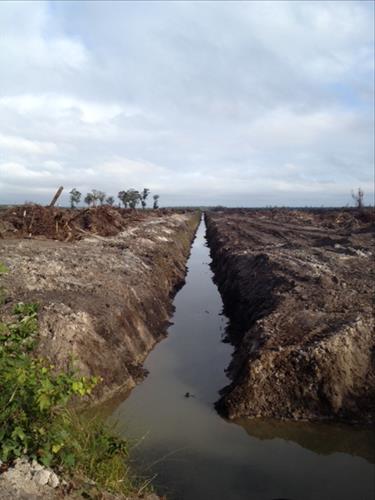BAYBORO — Five months after asking the Army Corps of Engineers to investigate alleged illegal ditching and draining of wetlands on hundreds of forested acres near the Neuse River, Pamlico County commissioners have grown impatient. They fired off a strongly worded letter last week asking the U.S. Environmental Protection Agency to send a representative to a meeting to address their ongoing worries about wetland draining.
The board, during its April 7 meeting, voted 4-2 to send the letter to Gina McCarthy, EPA administrator. It states that, “We have been very disappointed that wetlands continue to be lost and degraded due to lack of enforcement of wetlands rules by this agency. It is our understanding that your agency has been asked to look at this situation by the Corps, and that so far nothing has been done to stop the loss of these wetlands by your agency…”
Supporter Spotlight

Allen Propst |

Paul Delamar III |

Carl Ollison |
The word in the county is that EPA has written a letter to the owner of the property, Spring Creek Farms LLC of Illinois, but neither Tim Buck, Pamlico County manager, nor Paul Delamar III, chairman of the county commissioners, have yet to see it. Nor has the N.C. Coastal Federation, which since last year has been communicating with and prodding EPA and the Corps over what area residents contend has been widespread clearing and ditching of wetlands.
A spokesman in the EPA regional office in Atlanta said late last week that she would check into whether the letter had been written or sent, but then did not provide any information by press time. And Buck said Friday that the EPA had not yet responded to the letter the county emailed to the office earlier in the week.
Supporter Spotlight
The issue first arose last summer, when Allen Propst, a real-estate agent in Oriental, and farmers near the town of Merritt noticed that land-clearing operations had begun on a 4,658-acre tract owned by Spring Creek Farms. At the time about 250 acres on the south side of State Road 1324 had been cleared. Abel Harmon of Hydeland Construction & Consulting in Swanquarter, who was working on the project, said at the time that farming could begin any time after the land clearing was completed. It has not started yet.
Todd Miller, executive director of the federation, alerted the Corps that extensive ditching through wetlands may have occurred on the property. He asked the agency, which regulates most wetlands filling and ditching, to investigate. Corps’ and state regulators visited the site but said they saw no apparent violations under the Clean Water Act.
The federal law governs the filling of most wetlands. Forestry operators can dig small ditches to make land drier to aid in the growing or harvesting of trees, but ditches that lower the water table to extent that the wetlands are compromised or destroyed and the land converted to farming or other uses require a Corps’ permit.
Hundreds of county residents contacted the commissioners and attended meetings last fall. Propst said residents considered the issue a test of whether the federal and state governments will allow a renewal of major conversions of forest and wetlands to agriculture in the county and elsewhere along the N.C. coast. No such large-scale conversions have occurred along the coast in more than two decades. In fact, state and local governments have worked with environmental groups, including the federation, to halt the practice and in some cases begin major wetland restoration efforts.
Public outcry in the fall was so loud that the commissioners in November voted to ask the Corps to investigate the ditching. They also asked their planning board to draft an ordinance that would require landowners to notify the county before ditching and draining wetlands. Under the proposed ordinance, landowners would also need affirmative statements by responsible regulatory agencies that drainage of their land is allowed under federal and state laws. The planning board was to send the completed ordinance back to the commissioners for consideration in three months.
But County Manager Buck said Friday that effort has gone nowhere. “Our attorney looked into it and said there were a number of issues which basically would prevent us from doing anything meaningful,” he said. “It’s just not clear what we could do, if anything.”
Once that effort collapsed, Delamar said he and others on the county commission eventually came to think that they needed to do more, thus the letter to the EPA.

One of the ditches on the tract as it appeared last summer. |
“The reasoning was that the Corps has been out there and investigated but has not stopped it or done anything, really,” he said. “We are not against people using their property, but one of my major concerns is that there does not seem to be equal enforcement. Wetlands rules affect just about every property owner in Pamlico County. The county is that wet. If someone has an acre of land and wants to do something with it, he’s going to have to meet all the rules. But it seems that if a big corporation has 4,000 acres, they are able to do just about anything they want to do without first getting approval. And that’s not right.”
The majority of board agreed, after fairly intense debate on April 7, to send the letter to EPA. But Commissioner Carl Ollison, who cast one of the two dissenting votes, said he was willing to trust the federal government on the issue.
<p“I know how strict the standards are on wetlands, and if they determine something isn’t wetlands, well, they’re the experts and we should trust that determination,” he said. “If this was wetlands, they’d spend a lot more time pulling their equipment out than they would clearing the land, because wetlands don’t have a bottom.”
Delamar said he understands that some wanted the county board to do more than send a letter, and are still strongly supportive of a local ordinance. But, he said, it was not easy to generate enough support to send the letter, and there’s little or no support at present to do more than that. He said he’s disappointed that the state and federal governments have not been more attentive.
“I thought this (federal) administration would be more environmentally conscious, but at least with big owners, that doesn’t seem to be the case,” he said. “I would hope that if our people with smaller pieces of land start clearing land and burning up marshland, the enforcement is equally lax. This is really the kind of thing that gets citizens upset with government. It’s a fairness issue.”
Propst said Spring Creek Farms LLC, purchased the property from Copper Station through a holding company called Northeast Dakota Holdings LLC for $7.11 million, or just under $1,525 an acre. By converting this property to agricultural land, costing around $1,000 an acre for the conversion, and with farm land currently selling in Pamlico County for as much as $5,400 per acre, a future sale of $25 million could net as much as $13 million profit.
Propst said last week that people are still very concerned about the issue, but added that the furor has died down since the fall.
The county’s letter to EPA noted that Pamlico is a “very rural farm and fishing community that depends on having productive lands and coastal waters for our economy to thrive. The elected leadership of our county is not in favor of overly aggressive environmental mandates, but we do support consistent and equitable enforcement of necessary environmental safeguards to avoid spoiling the natural resources upon which our county depends for its economy and quality of life.”
The letter concludes by asking that a representative of EPA arrange to attend a county commission meeting to “provide us with a detailed and full explanation” of how wetlands on the tract are being protected.
“We have had county commission meetings attended by hundreds of citizens expressing their concerns about what they see happening to this land,” the letter notes. “We … believe … that if the wetlands on this parcel of land cannot be protected by the U.S. Army Corps of Engineers and the U.S. EPA, then wetlands can’t be protected anywhere. What we are seeing happening … goes a long way to explain why your agency is reporting unacceptable losses of coastal-forested wetlands nationally.”







